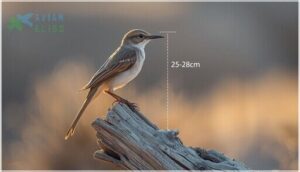This site is supported by our readers. We may earn a commission, at no cost to you, if you purchase through links.
You won’t spot LeConte’s thrasher unless you’re willing to stare into the heart of the most unforgiving desert scrub. This pale phantom moves through saltbush and creosote like smoke, built for landscapes that kill careless visitors.
Over the past five decades, something devastating has happened: populations have cratered by roughly 80%, pushing this sandy-feathered specialist toward the brink. The collapse isn’t abstract or theoretical. It’s unfolding across fractured desert pockets from California to Mexico, where habitat loss and climate shifts are rewriting the rules for survival.
Understanding what makes this thrasher tick—from its lightning-fast foraging strikes to its oddly specific nest placement—matters now more than ever.
Table Of Contents
- Key Takeaways
- Physical Characteristics of LeConte’s Thrasher
- Range and Habitat Preferences
- Diet and Foraging Behavior
- Breeding and Nesting Habits
- Conservation Status and Threats
- Frequently Asked Questions (FAQs)
- What is the range of the LeConte’s thrasher?
- What is the habitat of the LeConte’s thrasher?
- What are the adaptations of the LeConte’s thrasher?
- How long do LeContes Thrashers live?
- What is the population trend for LeContes Thrashers?
- Do LeContes Thrashers migrate or are they year-round residents?
- What are the main predators of LeContes Thrashers?
- How can people help conserve LeContes Thrashers?
- What sounds does LeContes Thrasher make?
- How does LeContes Thrasher avoid predators?
- Conclusion
Key Takeaways
- LeConte’s thrasher has lost roughly 80% of its population over the past five decades, earning it Red Alert conservation status with only 71,000 birds remaining globally and annual declines of 2.8–2.9%.
- This pale gray “desert ghost” survives in some of North America’s harshest terrain by extracting all moisture from prey, reflecting 30% more solar radiation than darker birds, and retreating to burrows up to 15°C cooler during midday heat.
- The species demands extremely specific habitat—flat desert with 30–40% shrub cover, sandy soil, and particular plants like saltbush and cholla—making it unable to adapt when habitat loss and urban sprawl fragment its range.
- Conservation requires protecting large connected habitat patches of 40–100 hectares per breeding pair, restoring native shrubs, and restricting off-road vehicles during breeding season to reverse the population crash before this specialist vanishes entirely.
Physical Characteristics of LeConte’s Thrasher
You can spot a LeConte’s Thrasher from its pale sandy gray appearance that earned it the nickname “gray ghost” of the desert. This secretive songbird stretches about 11 inches from bill to tail and weighs roughly 2.2 ounces.
Let’s break down what makes this thrasher stand out from other desert birds you’ll encounter.
Size, Weight, and Measurements
You’ll find LeConte’s Thrasher (Toxostoma lecontei) packing serious desert credentials into a surprisingly compact frame. This bird species measures 24.5–29 centimeters in body length, with a weight range spanning 55–76 grams.
Key morphometrics include:
- Bill size: 28–32 millimeters decurved
- Tail measurements: 10–13 centimeters (40–45% of total length)
- Tarsus: 33–38 millimeters for ground mobility
- Wing chord: 8.5–10.5 centimeters
- No sexual size dimorphism
Avian biology and wildlife biology reveal minimal geographic variation across populations. The beak morphology of LeConte’s Thrasher is influenced by its adaptation to climate change factors.
Plumage Coloration and Markings
You’re looking at plumage patterns evolved for ghosting through desert habitats. LeConte’s Thrasher rocks pale sandy gray-brown upperparts with darker tail contrast that screams desert camo. Check the peachy undertail wash and thin dark malar stripe—instant ID markers. Beak coloration stays uniformly dark while feather texture appears fluffier on juveniles.
The species is often identified by its desert habitat features.
| Feature | Adult Coloration |
|---|---|
| Upperparts | Sandy pale-gray |
| Underparts | Puffy gray (no spots) |
| Undertail | Peachy-rusty wash |
Distinctive Morphological Features
You’ll notice Toxostoma lecontei’s morphological toolkit is engineered for desert survival. Bill structure features a pronounced 2.7 cm decurved weapon for probing sandy soil. Leg morphology delivers nearly black stilts with extended tarsus length—perfect for sprinting across loose terrain.
That 12 cm tail composes half the body length, providing essential balance during ground foraging. Wing shape stays short and rounded, reflecting this bird species’ sedentary lifestyle rather than migratory habits.
Comparison With Other Thrasher Species
When comparing LeConte’s Thrasher to other thrasher birds, you’ll spot three defining contrasts that showcase its desert adaptation prowess:
- Bill Shape: LeConte’s sports a 25-30 mm decurved weapon—shorter than California and Crissal Thrashers but heftier than Bendire’s sub-25 mm tool
- Species Distribution: Unlike migratory Sage Thrashers, this avian behavior specialist stays resident year-round
- Bird Longevity: Recorded at 5 years 8 months maximum
Range and Habitat Preferences
You won’t find LeConte’s Thrashers lounging in your backyard birdbath. These gray ghosts stake their claim in some of the most unforgiving landscapes the American Southwest has to offer.
Here’s where these desert specialists make their home and how they’ve mastered life in the arid zone.
Geographic Distribution in North America
You’ll find LeConte’s Thrasher scattered across a surprisingly fractured desert range in the southwestern United States and northwestern Mexico. This bird’s North America territory spans southeastern California to southwestern Arizona, but habitat fragments and geographic isolation have carved up what was once a continuous desert ecosystem.
Population shifts driven by agriculture and urban sprawl leave many subpopulations stranded, with migration patterns virtually nonexistent since these desert ghosts stay put year-round.
Preferred Desert Habitats
You won’t spot these gray ghosts just anywhere in the desert. LeConte’s Thrashers demand flat, open desert landscapes with minimal vegetation density—usually under 30% cover—and sandy or fine-loamy soil quality. They avoid rocky terrain and dense shrublands, instead claiming vast arid ecosystems where saltbush and creosote dominate.
Habitat fragmentation has boxed them into increasingly isolated pockets, making contiguous desert habitats critical for their survival.
Vegetation and Terrain Selection
Shrub density matters more than you’d think—LeConte’s Thrasher occupancy peaks around 40% cover, favoring allscale saltbush, cholla cactus, and desert tea over pure creosote stands. Nesting sites cluster in sturdy shrubs between 1.8 and 6.3 feet tall on flat terrain with minimal slope, where habitat fragmentation hasn’t severed the desert ecosystem.
Mesquite and other desert floras provide secondary support, maintaining this delicate habitat preservation balance.
Adaptations to Arid Environments
You’ll find LeConte’s Thrasher thriving where precipitation drops below 50 mm annually—a feat of water conservation and thermoregulation few North American songbirds match. This desert survival specialist extracts nearly all moisture from prey, while pale plumage reflects 30% more solar radiation than darker species.
Drought adaptation includes midday retreats to burrows up to 15°C cooler than surface temperatures, preserving this arid ecology icon’s place in desert habitats and wildlife biology.
Diet and Foraging Behavior
LeConte’s thrashers are opportunistic hunters that have mastered the art of finding food in one of North America’s harshest environments. You’ll see these birds using their curved bills like specialized tools to uncover prey hidden beneath desert sand and debris.
Understanding what they eat and how they hunt reveals why these pale gray ghosts thrive where few other songbirds dare to venture.
Primary Food Sources
You’ll find LeConte’s Thrasher thriving on arthropod diet staples that make up over 70% of its meals. Desert foraging reveals a surprising menu of insects, seeds, and even vertebrate prey:
- Insect hunting targets beetles, grasshoppers, and ants as primary protein sources
- Seed consumption focuses on mesquite during late summer and fall
- Feeding behavior includes spiders, centipedes, and scorpions for hydration
- Berries supplement nutrition when arthropods become scarce
Foraging Techniques and Tools
You’ll witness ground foraging mastery when watching this desert ghost work its terrain. The bird’s decurved bill morphology—measuring up to 32 millimeters—functions like a precision rake for substrate probing through leaf litter.
Feeding behavior involves rapid probe-and-sweep techniques, averaging 15 to 25 strikes per minute during peak hunting. This bill design maximizes foraging efficiency when extracting insects from sandy soils beneath scattered shrubs.
Seasonal Dietary Variations
LeConte’s Thrasher adjusts its diet dramatically across seasons, tracking arthropod abundance and precipitation effects with precision timing. Insects dominate 80 percent of spring intake during peak breeding, while dietary adaptations shift this species toward seeds and berries—reaching 40 percent—by late summer.
Food source shifts follow desert rainfall patterns, with wet winters boosting foraging strategies and prey diversity by 30 percent.
Role in The Desert Ecosystem
Beyond filling its belly, you’ll find this gray ghost acts as a critical ecosystem engineer in desert landscapes. LeConte’s Thrasher drives soil turnover and seed dispersal while occupying a central position in trophic dynamics—connecting invertebrate populations to higher predators.
Its presence signals vigorous biodiversity, making wildlife conservation and habitat and territory preservation essential for maintaining desert ecosystem health across arid regions.
Breeding and Nesting Habits
LeConte’s thrashers don’t follow the typical bird playbook regarding raising their young. These desert dwellers form tight pair bonds and stick together year-round, building their nests in the sparse vegetation that dots their harsh landscape.
Here’s what you need to know about how these gray ghosts bring the following cohort into the world.
Mating and Pair Bonding
Devotion drives LeContes Thrasher pair bonding, with monogamy patterns lasting years or even lifetimes. Courtship displays include males raising bills, bowing, and presenting twigs, while females respond with wing fluttering and begging calls.
These breeding habits establish bonds reinforced through territorial defense and mutual care. Mate selection creates stable partnerships across 15-acre nesting territories, with both partners sharing incubation and chick-rearing duties throughout the breeding season.
Nest Site Selection and Construction
Once pair bonding solidifies, you’ll find these desert architects selecting nest sites with precision. Their avian nesting habits reveal distinct microhabitat preferences:
- 82% choose cholla or saltbush shrubs for nest architecture
- Placement averages 83 cm above ground in dense vegetation
- Thorny branches deter predators from the nest site
- Twigs form the structure, lined with softer nesting materials
- Sites feature 60–80% bare ground, maximizing desert adaptations
Bird breeding habits reflect survival instincts honed across millennia.
Egg Laying and Incubation
Between February and June, you’ll witness the female lay 2–4 bluish-green eggs daily until her clutch completes. Avian nesting habits show both sexes share incubation periods lasting 14–20 days, alternating duties while safeguarding their investment.
Egg formation timing aligns with insect abundance, maximizing nesting success. Bird breeding habits produce up to three broods annually, though only 64% of nests fledge young—evidence of harsh desert realities affecting clutch sizes and fledging rates.
Chick Development and Parental Care
Once LeConte’s thrasher nestlings hatch, you’ll observe both parents sharing feeding duties for 12–20 days until fledging occurs between days 14–18. Parental roles intensify as they provision young with insects and defend territories, achieving 64% fledgling success across monitored nests.
- Nestling growth accelerates rapidly, preparing chicks for juvenile dispersal averaging 679 meters from natal sites
- Post-fledging survival reaches 46%, with chick mortality highest during early independence
- Parents continue feeding fledglings 15–18 additional days, balancing care if another brood begins
Conservation Status and Threats
LeConte’s Thrasher sits on the U.S. Continental Red List as a species of highest conservation concern. Population numbers are dropping fast across its desert range, and the reasons behind this decline paint a troubling picture.
You’ll want to understand what’s pushing this pale gray ghost toward the edge and what can be done to pull it back.
Current Population Trends
You’re witnessing one of North America’s steepest wildlife population declines. LeConte’s thrasher has crashed approximately 80% from 1968 to 2023, earning its Red Alert Tipping Point conservation status.
LeConte’s thrasher has plummeted 80% since 1968, now Red Alert status among North America’s most endangered birds
The desert ecosystem’s “gray ghost” now numbers just 71,000 globally, with annual losses hitting 2.8–2.9% per year. Bird conservation efforts face urgent pressure as habitat loss pushes this species toward extinction.
Major Threats to Survival
You’re watching habitat loss slice through desert landscapes at breakneck speed—nearly 70% of LeConte’s thrashers vanished in just 50 years. Climate change cranks up heat and drought, hammering nest success.
Human disturbance from off-road vehicles crushes eggs, while invasive species fuel wildfires that torch nesting sites. Pollution effects from oil sumps trap birds.
Environmental threats to wildlife converge here, pushing habitat degradation past the tipping point.
Conservation Efforts and Management
Desert ecosystem conservation hangs on bold moves—you can’t just watch this gray ghost vanish. Wildlife conservation efforts target LeConte’s thrasher through binational teams meeting four times yearly to coordinate species protection.
- Habitat restoration propagates native shrubs across degraded patches spanning hundreds of acres
- Legal petitions push Endangered Species Act listing as of September 2025
- Conservation funding fuels monitoring surveys during winter months with centralized data tracking
- Ecosystem management enforces breeding-season restrictions on off-road vehicles
- Wildlife preservation includes revegetating industrial sites post-construction
Bird conservation efforts rally partnerships to reverse that brutal 2.9% annual decline.
Importance of Habitat Preservation
You can’t rebuild a species without the ground it walks on. Habitat restoration anchors wildlife conservation for this vanishing thrasher—preserving intact desert ecosystems maintains environmental sustainability by protecting nesting shrubs and foraging zones.
Desert ecology depends on connected habitat patches spanning those critical 40 to 100 hectares per pair. Conservation efforts targeting desert habitat preservation directly counter that 70% population crash threatening ecosystem balance.
Frequently Asked Questions (FAQs)
What is the range of the LeConte’s thrasher?
You’ll spot this elusive gray ghost across southeastern California, southern Nevada, southwestern Utah, and western Arizona, extending into northwestern Mexico’s Baja California and Sonora regions, always below 1,150 meters elevation.
What is the habitat of the LeConte’s thrasher?
You’ll find this bird in sparsely vegetated desert landscapes with sandy, alkaline soil composition. It thrives in arid ecosystems featuring creosote bush, saltbush, and cholla—habitats where water availability is minimal yet critical for wildlife habitat conservation.
What are the adaptations of the LeConte’s thrasher?
You’ll be stunned by the masterclass in arid survival this bird species displays. Desert camouflage plumage, adaptive bill for ground foraging, and remarkable drought tolerance make LeConte’s thrasher (Toxostoma lecontei) perfectly suited to desert habitats.
How long do LeContes Thrashers live?
You can expect LeConte’s Thrasher (Toxostoma lecontei) to live seven to eight years on average, though longevity trends show banded individuals rarely surpass six years due to mortality rates in harsh desert conditions.
What is the population trend for LeContes Thrashers?
This desert ghost is fading fast. LeConte’s Thrasher populations have plummeted roughly 80% over 55 years, declining 8–9% annually since 1968 due to habitat loss, urbanization, and agricultural expansion across their southwestern range.
Do LeContes Thrashers migrate or are they year-round residents?
You won’t catch these gray ghosts packing their bags. LeConte’s thrashers stick around year-round as permanent residents, defending the same arid territories through every season without migration routes or seasonal movements disrupting their habitat stability.
What are the main predators of LeContes Thrashers?
Like many ground-nesting songbirds, you’ll find these gray ghosts facing avian predators including roadrunners and hawks, reptile threats from desert snakes, and mammal attacks by coyotes, cats, and antelope squirrels raiding nests.
How can people help conserve LeContes Thrashers?
You can support LeConte’s thrasher conservation efforts through habitat restoration projects, volunteer monitoring programs, and advocating for species protection policies.
Community engagement in wildlife preservation and eco-friendly practices helps safeguard these vulnerable desert birds.
What sounds does LeContes Thrasher make?
You’ll hear LeConte’s thrasher’s signature rising whistle—a soft, ascending “suuuweeeep”—echoing across the desert.
This gray ghost also mimics neighboring bird species, weaving borrowed phrases into complex, undulating songs that define its territory.
How does LeContes Thrasher avoid predators?
You’ll spot predator evasion through camouflage tactics and escape behaviors.
LeConte’s thrasher blends into sandy terrain with cryptic plumage, runs swiftly instead of flying, and selects dense shrub cover for temporal avoidance within desert ecosystems.
Conclusion
What happens when the desert’s quietest survivor loses the ground beneath its feet? LeConte’s thrasher won’t adapt to suburban sprawl or pivot to new terrain. It vanishes.
Your awareness changes that trajectory. Whether you’re advocating for protected corridors or simply refusing to let this pale ghost fade into obscurity, you’re holding the line.
The desert doesn’t negotiate second chances, and neither should we when a species this specialized faces erasure.
- https://sonoranjv.org/desert-thrashers/
- https://esrp.csustan.edu/speciesprofiles/profile.php?sp=tole
- https://en.wikipedia.org/wiki/LeConte's_thrasher
- https://borderlandsbirds.org/wp-content/uploads/2025/01/Desert-Thrasher-Conservation-Strategy_v1.0Dec2024.pdf
- http://www.allaboutbirds.org/guide/Le_Contes_Thrasher/id












